Neonatal Jaundice: Clinical Research, Assessment & Family Care
VerifiedAdded on 2023/06/13
|10
|2525
|255
Essay
AI Summary
This essay critically evaluates clinical research related to neonatal jaundice, addressing the pathophysiology of the condition, interpreting assessment data from a case study, and discussing the nurse's role in fostering a family-centered care approach. The essay begins by explaining the pathophysiology of physiologic jaundice in newborns, highlighting the role of immature liver function and bilirubin production. It then interprets assessment data, including heart rate, respiratory rate, oxygen saturation, temperature, and total serum bilirubin levels, relating these to the infant's condition. Finally, the essay emphasizes the importance of family-centered care, discussing how nurses can establish partnerships with families, provide education, and ensure the well-being of both the infant and the family, ultimately improving the quality of care and outcomes for newborns with jaundice.
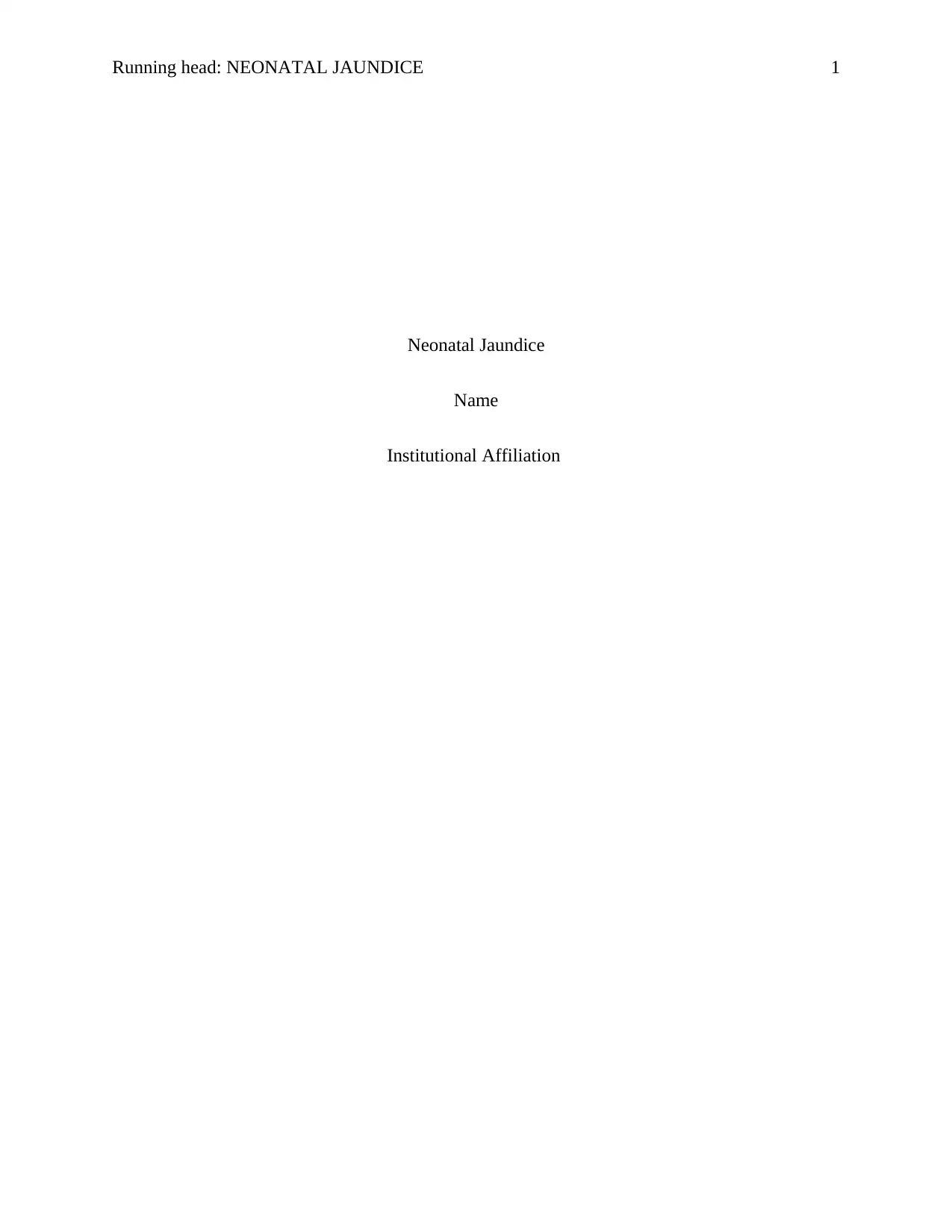
Running head: NEONATAL JAUNDICE 1
Neonatal Jaundice
Name
Institutional Affiliation
Neonatal Jaundice
Name
Institutional Affiliation
Paraphrase This Document
Need a fresh take? Get an instant paraphrase of this document with our AI Paraphraser
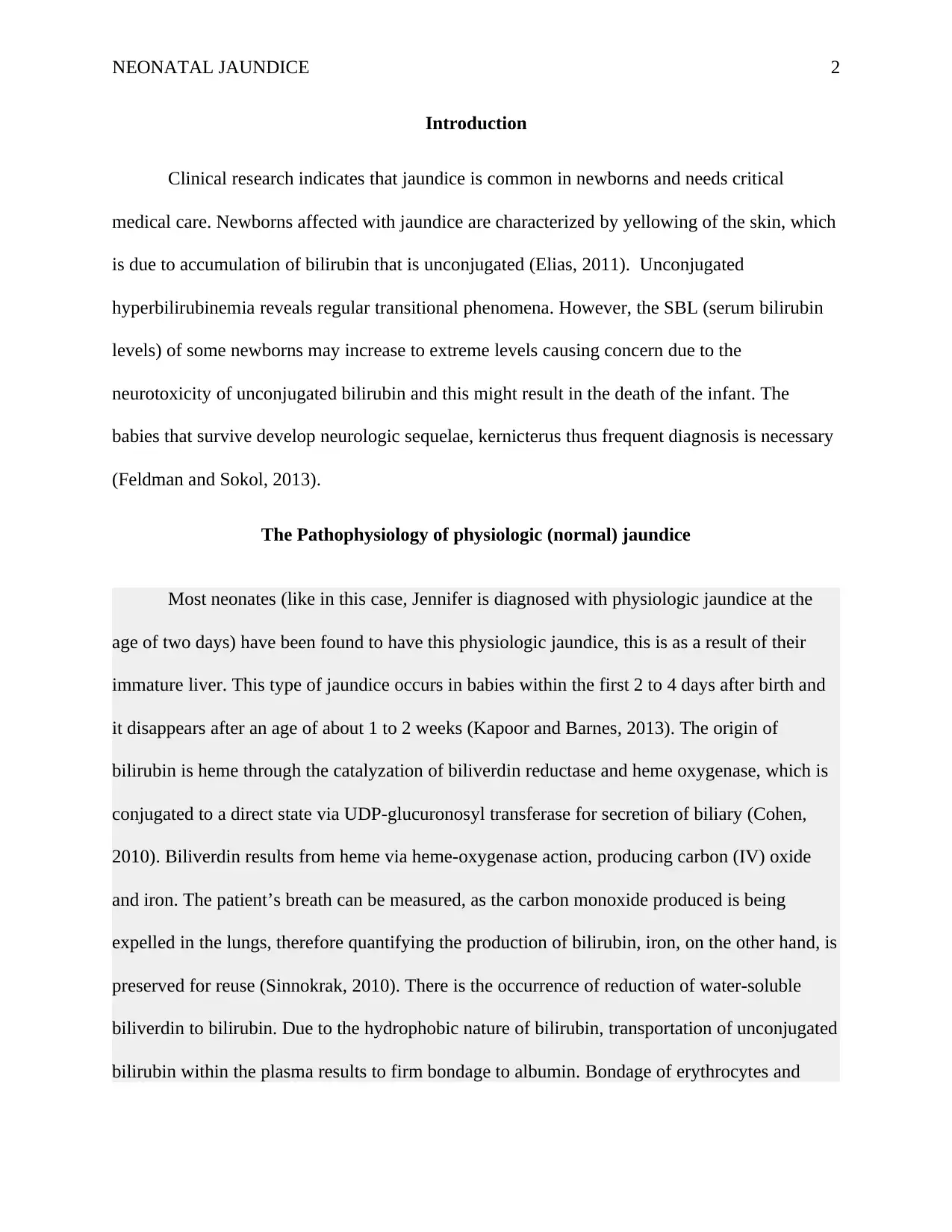
NEONATAL JAUNDICE 2
Introduction
Clinical research indicates that jaundice is common in newborns and needs critical
medical care. Newborns affected with jaundice are characterized by yellowing of the skin, which
is due to accumulation of bilirubin that is unconjugated (Elias, 2011). Unconjugated
hyperbilirubinemia reveals regular transitional phenomena. However, the SBL (serum bilirubin
levels) of some newborns may increase to extreme levels causing concern due to the
neurotoxicity of unconjugated bilirubin and this might result in the death of the infant. The
babies that survive develop neurologic sequelae, kernicterus thus frequent diagnosis is necessary
(Feldman and Sokol, 2013).
The Pathophysiology of physiologic (normal) jaundice
Most neonates (like in this case, Jennifer is diagnosed with physiologic jaundice at the
age of two days) have been found to have this physiologic jaundice, this is as a result of their
immature liver. This type of jaundice occurs in babies within the first 2 to 4 days after birth and
it disappears after an age of about 1 to 2 weeks (Kapoor and Barnes, 2013). The origin of
bilirubin is heme through the catalyzation of biliverdin reductase and heme oxygenase, which is
conjugated to a direct state via UDP-glucuronosyl transferase for secretion of biliary (Cohen,
2010). Biliverdin results from heme via heme-oxygenase action, producing carbon (IV) oxide
and iron. The patient’s breath can be measured, as the carbon monoxide produced is being
expelled in the lungs, therefore quantifying the production of bilirubin, iron, on the other hand, is
preserved for reuse (Sinnokrak, 2010). There is the occurrence of reduction of water-soluble
biliverdin to bilirubin. Due to the hydrophobic nature of bilirubin, transportation of unconjugated
bilirubin within the plasma results to firm bondage to albumin. Bondage of erythrocytes and
Introduction
Clinical research indicates that jaundice is common in newborns and needs critical
medical care. Newborns affected with jaundice are characterized by yellowing of the skin, which
is due to accumulation of bilirubin that is unconjugated (Elias, 2011). Unconjugated
hyperbilirubinemia reveals regular transitional phenomena. However, the SBL (serum bilirubin
levels) of some newborns may increase to extreme levels causing concern due to the
neurotoxicity of unconjugated bilirubin and this might result in the death of the infant. The
babies that survive develop neurologic sequelae, kernicterus thus frequent diagnosis is necessary
(Feldman and Sokol, 2013).
The Pathophysiology of physiologic (normal) jaundice
Most neonates (like in this case, Jennifer is diagnosed with physiologic jaundice at the
age of two days) have been found to have this physiologic jaundice, this is as a result of their
immature liver. This type of jaundice occurs in babies within the first 2 to 4 days after birth and
it disappears after an age of about 1 to 2 weeks (Kapoor and Barnes, 2013). The origin of
bilirubin is heme through the catalyzation of biliverdin reductase and heme oxygenase, which is
conjugated to a direct state via UDP-glucuronosyl transferase for secretion of biliary (Cohen,
2010). Biliverdin results from heme via heme-oxygenase action, producing carbon (IV) oxide
and iron. The patient’s breath can be measured, as the carbon monoxide produced is being
expelled in the lungs, therefore quantifying the production of bilirubin, iron, on the other hand, is
preserved for reuse (Sinnokrak, 2010). There is the occurrence of reduction of water-soluble
biliverdin to bilirubin. Due to the hydrophobic nature of bilirubin, transportation of unconjugated
bilirubin within the plasma results to firm bondage to albumin. Bondage of erythrocytes and
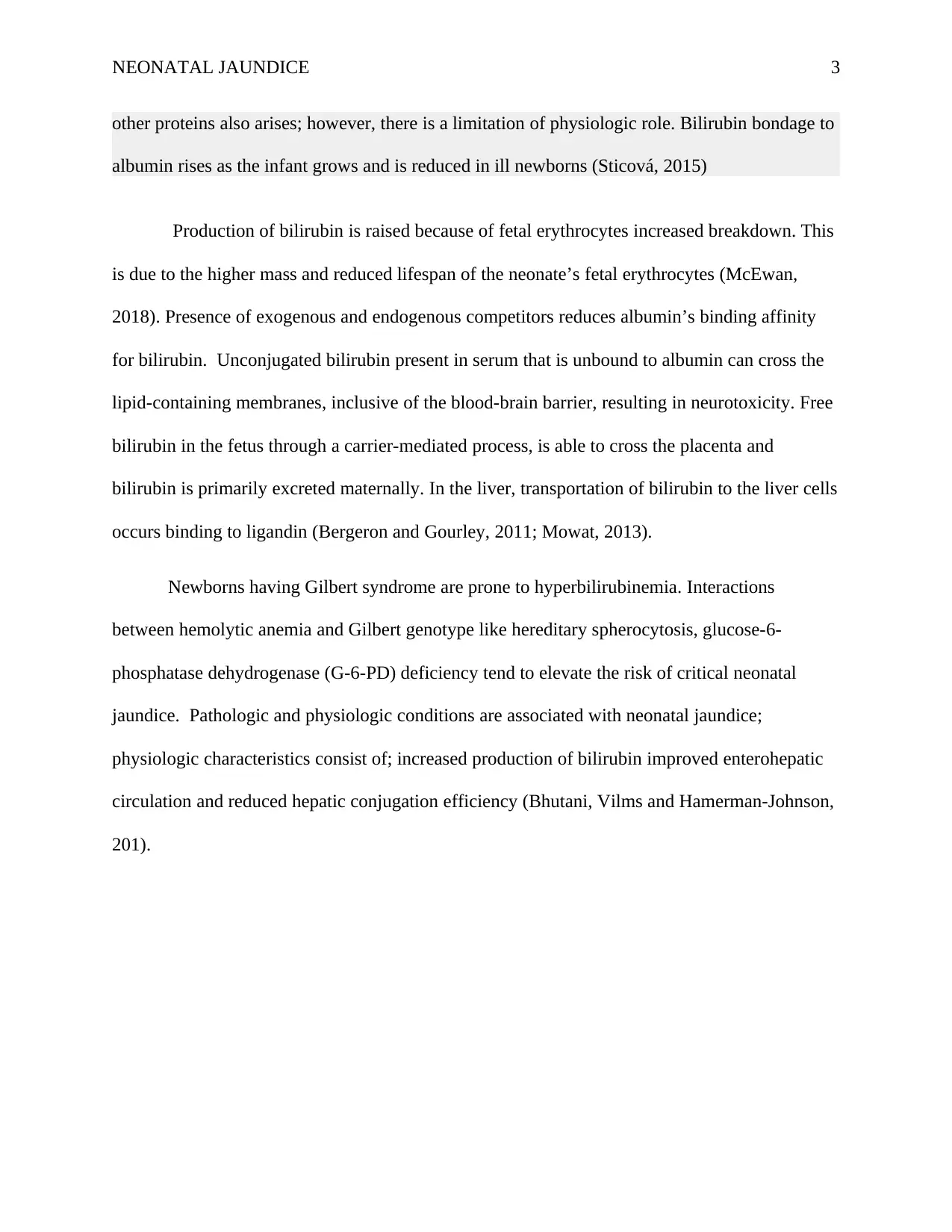
NEONATAL JAUNDICE 3
other proteins also arises; however, there is a limitation of physiologic role. Bilirubin bondage to
albumin rises as the infant grows and is reduced in ill newborns (Sticová, 2015)
Production of bilirubin is raised because of fetal erythrocytes increased breakdown. This
is due to the higher mass and reduced lifespan of the neonate’s fetal erythrocytes (McEwan,
2018). Presence of exogenous and endogenous competitors reduces albumin’s binding affinity
for bilirubin. Unconjugated bilirubin present in serum that is unbound to albumin can cross the
lipid-containing membranes, inclusive of the blood-brain barrier, resulting in neurotoxicity. Free
bilirubin in the fetus through a carrier-mediated process, is able to cross the placenta and
bilirubin is primarily excreted maternally. In the liver, transportation of bilirubin to the liver cells
occurs binding to ligandin (Bergeron and Gourley, 2011; Mowat, 2013).
Newborns having Gilbert syndrome are prone to hyperbilirubinemia. Interactions
between hemolytic anemia and Gilbert genotype like hereditary spherocytosis, glucose-6-
phosphatase dehydrogenase (G-6-PD) deficiency tend to elevate the risk of critical neonatal
jaundice. Pathologic and physiologic conditions are associated with neonatal jaundice;
physiologic characteristics consist of; increased production of bilirubin improved enterohepatic
circulation and reduced hepatic conjugation efficiency (Bhutani, Vilms and Hamerman-Johnson,
201).
other proteins also arises; however, there is a limitation of physiologic role. Bilirubin bondage to
albumin rises as the infant grows and is reduced in ill newborns (Sticová, 2015)
Production of bilirubin is raised because of fetal erythrocytes increased breakdown. This
is due to the higher mass and reduced lifespan of the neonate’s fetal erythrocytes (McEwan,
2018). Presence of exogenous and endogenous competitors reduces albumin’s binding affinity
for bilirubin. Unconjugated bilirubin present in serum that is unbound to albumin can cross the
lipid-containing membranes, inclusive of the blood-brain barrier, resulting in neurotoxicity. Free
bilirubin in the fetus through a carrier-mediated process, is able to cross the placenta and
bilirubin is primarily excreted maternally. In the liver, transportation of bilirubin to the liver cells
occurs binding to ligandin (Bergeron and Gourley, 2011; Mowat, 2013).
Newborns having Gilbert syndrome are prone to hyperbilirubinemia. Interactions
between hemolytic anemia and Gilbert genotype like hereditary spherocytosis, glucose-6-
phosphatase dehydrogenase (G-6-PD) deficiency tend to elevate the risk of critical neonatal
jaundice. Pathologic and physiologic conditions are associated with neonatal jaundice;
physiologic characteristics consist of; increased production of bilirubin improved enterohepatic
circulation and reduced hepatic conjugation efficiency (Bhutani, Vilms and Hamerman-Johnson,
201).
⊘ This is a preview!⊘
Do you want full access?
Subscribe today to unlock all pages.

Trusted by 1+ million students worldwide
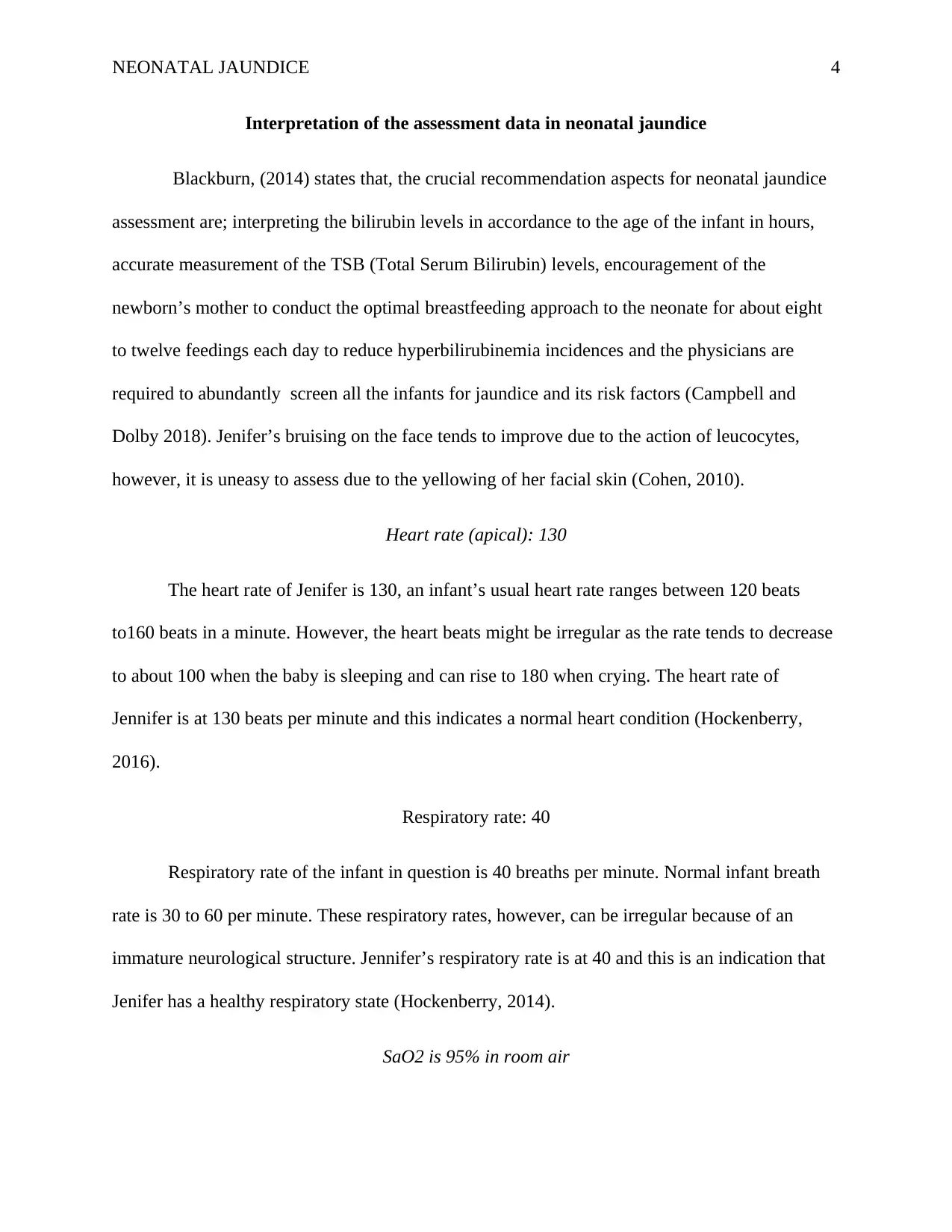
NEONATAL JAUNDICE 4
Interpretation of the assessment data in neonatal jaundice
Blackburn, (2014) states that, the crucial recommendation aspects for neonatal jaundice
assessment are; interpreting the bilirubin levels in accordance to the age of the infant in hours,
accurate measurement of the TSB (Total Serum Bilirubin) levels, encouragement of the
newborn’s mother to conduct the optimal breastfeeding approach to the neonate for about eight
to twelve feedings each day to reduce hyperbilirubinemia incidences and the physicians are
required to abundantly screen all the infants for jaundice and its risk factors (Campbell and
Dolby 2018). Jenifer’s bruising on the face tends to improve due to the action of leucocytes,
however, it is uneasy to assess due to the yellowing of her facial skin (Cohen, 2010).
Heart rate (apical): 130
The heart rate of Jenifer is 130, an infant’s usual heart rate ranges between 120 beats
to160 beats in a minute. However, the heart beats might be irregular as the rate tends to decrease
to about 100 when the baby is sleeping and can rise to 180 when crying. The heart rate of
Jennifer is at 130 beats per minute and this indicates a normal heart condition (Hockenberry,
2016).
Respiratory rate: 40
Respiratory rate of the infant in question is 40 breaths per minute. Normal infant breath
rate is 30 to 60 per minute. These respiratory rates, however, can be irregular because of an
immature neurological structure. Jennifer’s respiratory rate is at 40 and this is an indication that
Jenifer has a healthy respiratory state (Hockenberry, 2014).
SaO2 is 95% in room air
Interpretation of the assessment data in neonatal jaundice
Blackburn, (2014) states that, the crucial recommendation aspects for neonatal jaundice
assessment are; interpreting the bilirubin levels in accordance to the age of the infant in hours,
accurate measurement of the TSB (Total Serum Bilirubin) levels, encouragement of the
newborn’s mother to conduct the optimal breastfeeding approach to the neonate for about eight
to twelve feedings each day to reduce hyperbilirubinemia incidences and the physicians are
required to abundantly screen all the infants for jaundice and its risk factors (Campbell and
Dolby 2018). Jenifer’s bruising on the face tends to improve due to the action of leucocytes,
however, it is uneasy to assess due to the yellowing of her facial skin (Cohen, 2010).
Heart rate (apical): 130
The heart rate of Jenifer is 130, an infant’s usual heart rate ranges between 120 beats
to160 beats in a minute. However, the heart beats might be irregular as the rate tends to decrease
to about 100 when the baby is sleeping and can rise to 180 when crying. The heart rate of
Jennifer is at 130 beats per minute and this indicates a normal heart condition (Hockenberry,
2016).
Respiratory rate: 40
Respiratory rate of the infant in question is 40 breaths per minute. Normal infant breath
rate is 30 to 60 per minute. These respiratory rates, however, can be irregular because of an
immature neurological structure. Jennifer’s respiratory rate is at 40 and this is an indication that
Jenifer has a healthy respiratory state (Hockenberry, 2014).
SaO2 is 95% in room air
Paraphrase This Document
Need a fresh take? Get an instant paraphrase of this document with our AI Paraphraser
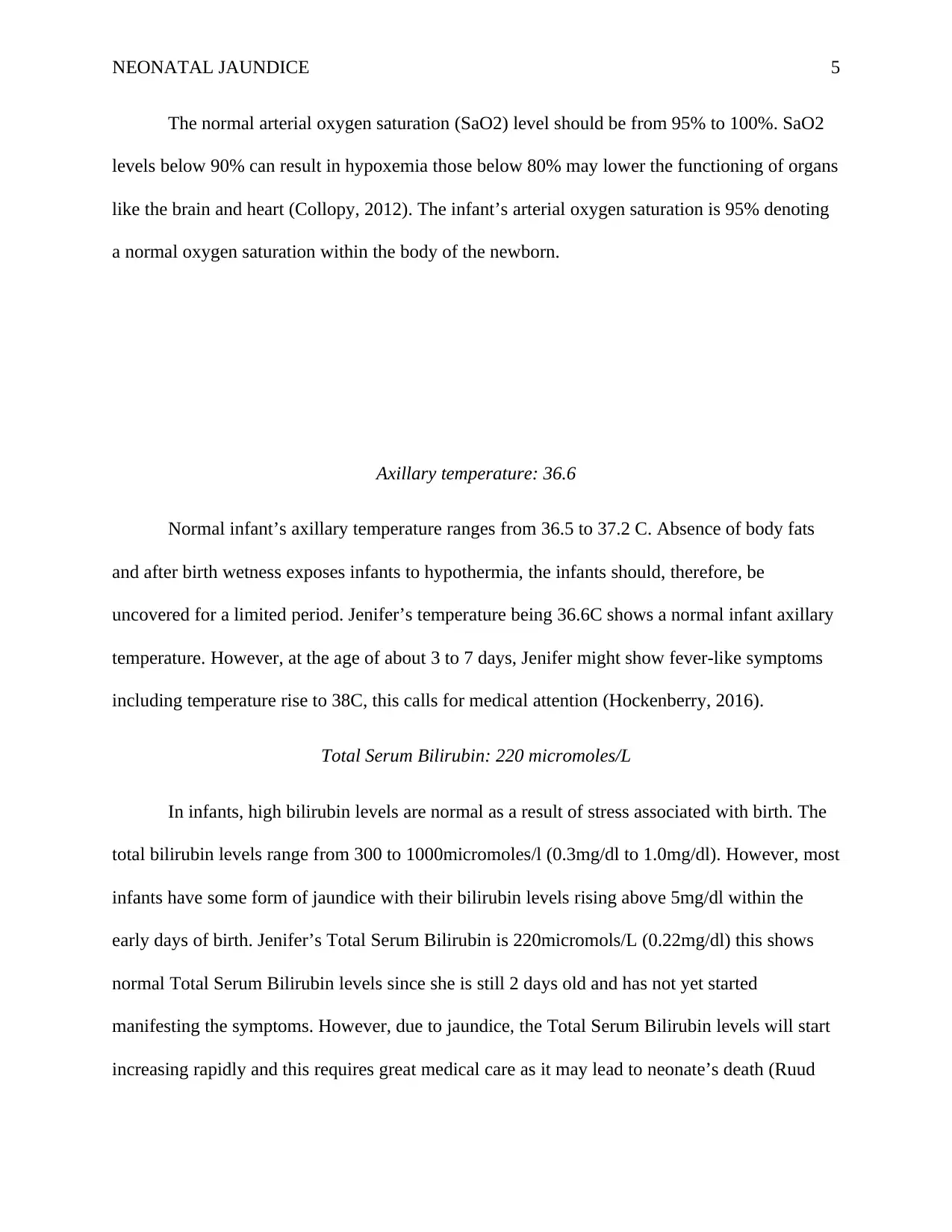
NEONATAL JAUNDICE 5
The normal arterial oxygen saturation (SaO2) level should be from 95% to 100%. SaO2
levels below 90% can result in hypoxemia those below 80% may lower the functioning of organs
like the brain and heart (Collopy, 2012). The infant’s arterial oxygen saturation is 95% denoting
a normal oxygen saturation within the body of the newborn.
Axillary temperature: 36.6
Normal infant’s axillary temperature ranges from 36.5 to 37.2 C. Absence of body fats
and after birth wetness exposes infants to hypothermia, the infants should, therefore, be
uncovered for a limited period. Jenifer’s temperature being 36.6C shows a normal infant axillary
temperature. However, at the age of about 3 to 7 days, Jenifer might show fever-like symptoms
including temperature rise to 38C, this calls for medical attention (Hockenberry, 2016).
Total Serum Bilirubin: 220 micromoles/L
In infants, high bilirubin levels are normal as a result of stress associated with birth. The
total bilirubin levels range from 300 to 1000micromoles/l (0.3mg/dl to 1.0mg/dl). However, most
infants have some form of jaundice with their bilirubin levels rising above 5mg/dl within the
early days of birth. Jenifer’s Total Serum Bilirubin is 220micromols/L (0.22mg/dl) this shows
normal Total Serum Bilirubin levels since she is still 2 days old and has not yet started
manifesting the symptoms. However, due to jaundice, the Total Serum Bilirubin levels will start
increasing rapidly and this requires great medical care as it may lead to neonate’s death (Ruud
The normal arterial oxygen saturation (SaO2) level should be from 95% to 100%. SaO2
levels below 90% can result in hypoxemia those below 80% may lower the functioning of organs
like the brain and heart (Collopy, 2012). The infant’s arterial oxygen saturation is 95% denoting
a normal oxygen saturation within the body of the newborn.
Axillary temperature: 36.6
Normal infant’s axillary temperature ranges from 36.5 to 37.2 C. Absence of body fats
and after birth wetness exposes infants to hypothermia, the infants should, therefore, be
uncovered for a limited period. Jenifer’s temperature being 36.6C shows a normal infant axillary
temperature. However, at the age of about 3 to 7 days, Jenifer might show fever-like symptoms
including temperature rise to 38C, this calls for medical attention (Hockenberry, 2016).
Total Serum Bilirubin: 220 micromoles/L
In infants, high bilirubin levels are normal as a result of stress associated with birth. The
total bilirubin levels range from 300 to 1000micromoles/l (0.3mg/dl to 1.0mg/dl). However, most
infants have some form of jaundice with their bilirubin levels rising above 5mg/dl within the
early days of birth. Jenifer’s Total Serum Bilirubin is 220micromols/L (0.22mg/dl) this shows
normal Total Serum Bilirubin levels since she is still 2 days old and has not yet started
manifesting the symptoms. However, due to jaundice, the Total Serum Bilirubin levels will start
increasing rapidly and this requires great medical care as it may lead to neonate’s death (Ruud
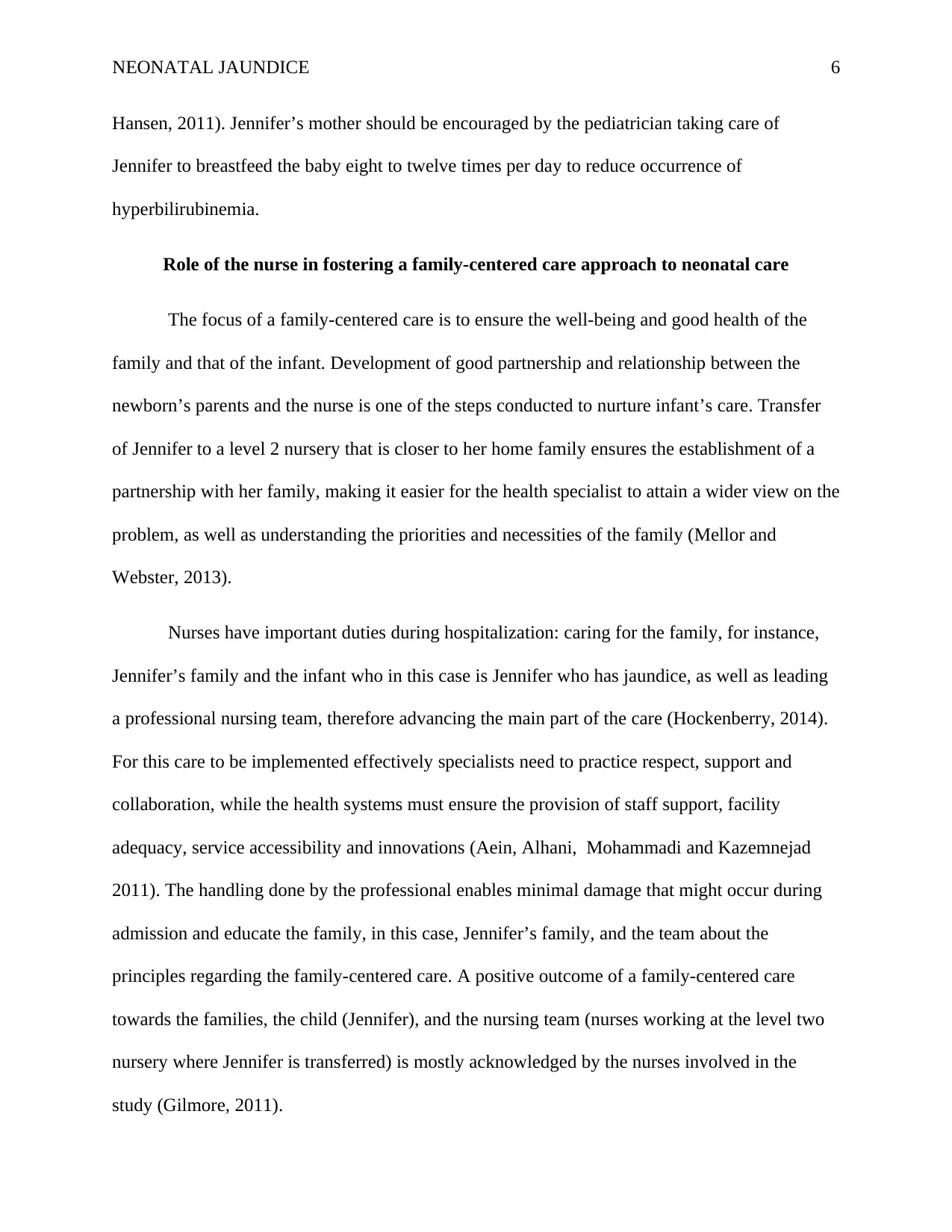
NEONATAL JAUNDICE 6
Hansen, 2011). Jennifer’s mother should be encouraged by the pediatrician taking care of
Jennifer to breastfeed the baby eight to twelve times per day to reduce occurrence of
hyperbilirubinemia.
Role of the nurse in fostering a family-centered care approach to neonatal care
The focus of a family-centered care is to ensure the well-being and good health of the
family and that of the infant. Development of good partnership and relationship between the
newborn’s parents and the nurse is one of the steps conducted to nurture infant’s care. Transfer
of Jennifer to a level 2 nursery that is closer to her home family ensures the establishment of a
partnership with her family, making it easier for the health specialist to attain a wider view on the
problem, as well as understanding the priorities and necessities of the family (Mellor and
Webster, 2013).
Nurses have important duties during hospitalization: caring for the family, for instance,
Jennifer’s family and the infant who in this case is Jennifer who has jaundice, as well as leading
a professional nursing team, therefore advancing the main part of the care (Hockenberry, 2014).
For this care to be implemented effectively specialists need to practice respect, support and
collaboration, while the health systems must ensure the provision of staff support, facility
adequacy, service accessibility and innovations (Aein, Alhani, Mohammadi and Kazemnejad
2011). The handling done by the professional enables minimal damage that might occur during
admission and educate the family, in this case, Jennifer’s family, and the team about the
principles regarding the family-centered care. A positive outcome of a family-centered care
towards the families, the child (Jennifer), and the nursing team (nurses working at the level two
nursery where Jennifer is transferred) is mostly acknowledged by the nurses involved in the
study (Gilmore, 2011).
Hansen, 2011). Jennifer’s mother should be encouraged by the pediatrician taking care of
Jennifer to breastfeed the baby eight to twelve times per day to reduce occurrence of
hyperbilirubinemia.
Role of the nurse in fostering a family-centered care approach to neonatal care
The focus of a family-centered care is to ensure the well-being and good health of the
family and that of the infant. Development of good partnership and relationship between the
newborn’s parents and the nurse is one of the steps conducted to nurture infant’s care. Transfer
of Jennifer to a level 2 nursery that is closer to her home family ensures the establishment of a
partnership with her family, making it easier for the health specialist to attain a wider view on the
problem, as well as understanding the priorities and necessities of the family (Mellor and
Webster, 2013).
Nurses have important duties during hospitalization: caring for the family, for instance,
Jennifer’s family and the infant who in this case is Jennifer who has jaundice, as well as leading
a professional nursing team, therefore advancing the main part of the care (Hockenberry, 2014).
For this care to be implemented effectively specialists need to practice respect, support and
collaboration, while the health systems must ensure the provision of staff support, facility
adequacy, service accessibility and innovations (Aein, Alhani, Mohammadi and Kazemnejad
2011). The handling done by the professional enables minimal damage that might occur during
admission and educate the family, in this case, Jennifer’s family, and the team about the
principles regarding the family-centered care. A positive outcome of a family-centered care
towards the families, the child (Jennifer), and the nursing team (nurses working at the level two
nursery where Jennifer is transferred) is mostly acknowledged by the nurses involved in the
study (Gilmore, 2011).
⊘ This is a preview!⊘
Do you want full access?
Subscribe today to unlock all pages.

Trusted by 1+ million students worldwide
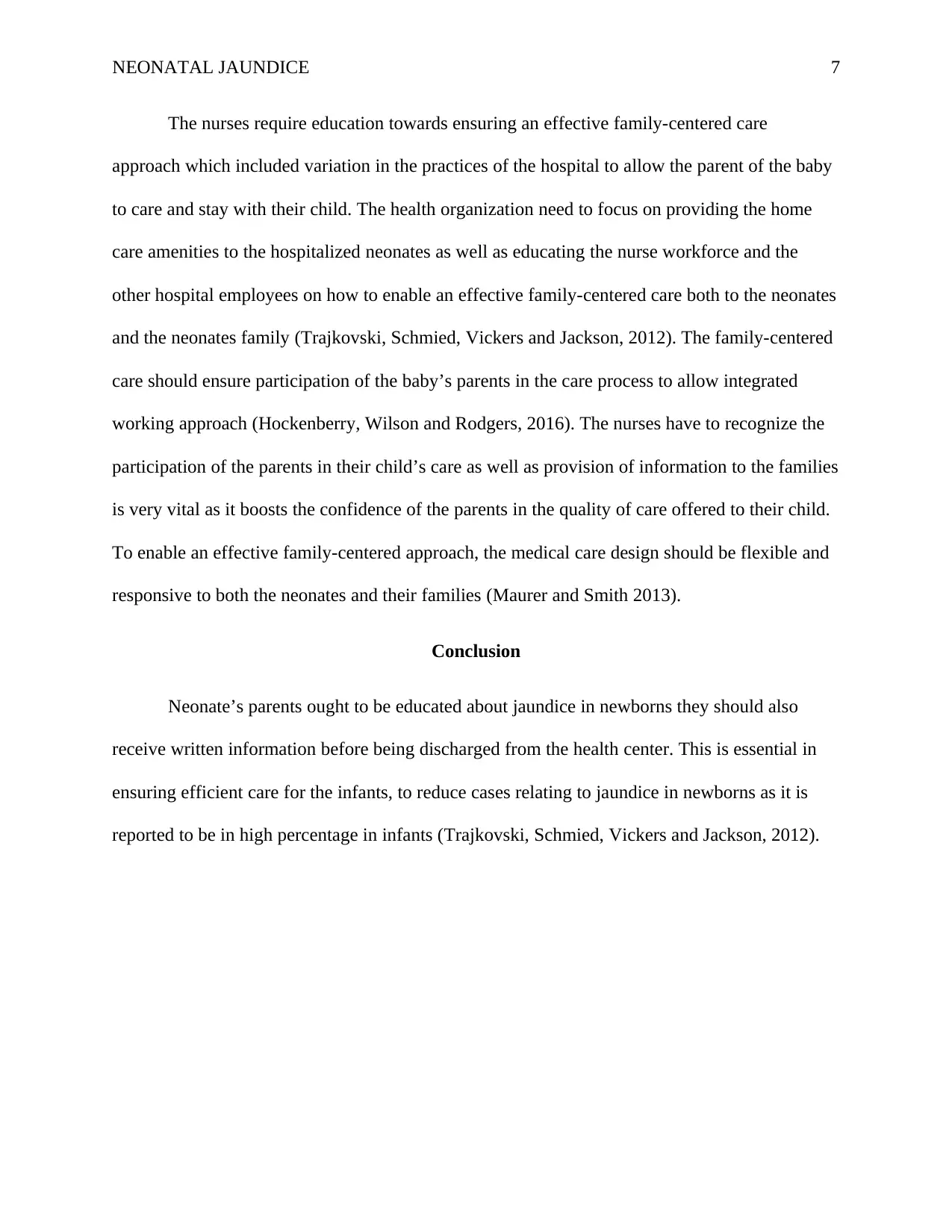
NEONATAL JAUNDICE 7
The nurses require education towards ensuring an effective family-centered care
approach which included variation in the practices of the hospital to allow the parent of the baby
to care and stay with their child. The health organization need to focus on providing the home
care amenities to the hospitalized neonates as well as educating the nurse workforce and the
other hospital employees on how to enable an effective family-centered care both to the neonates
and the neonates family (Trajkovski, Schmied, Vickers and Jackson, 2012). The family-centered
care should ensure participation of the baby’s parents in the care process to allow integrated
working approach (Hockenberry, Wilson and Rodgers, 2016). The nurses have to recognize the
participation of the parents in their child’s care as well as provision of information to the families
is very vital as it boosts the confidence of the parents in the quality of care offered to their child.
To enable an effective family-centered approach, the medical care design should be flexible and
responsive to both the neonates and their families (Maurer and Smith 2013).
Conclusion
Neonate’s parents ought to be educated about jaundice in newborns they should also
receive written information before being discharged from the health center. This is essential in
ensuring efficient care for the infants, to reduce cases relating to jaundice in newborns as it is
reported to be in high percentage in infants (Trajkovski, Schmied, Vickers and Jackson, 2012).
The nurses require education towards ensuring an effective family-centered care
approach which included variation in the practices of the hospital to allow the parent of the baby
to care and stay with their child. The health organization need to focus on providing the home
care amenities to the hospitalized neonates as well as educating the nurse workforce and the
other hospital employees on how to enable an effective family-centered care both to the neonates
and the neonates family (Trajkovski, Schmied, Vickers and Jackson, 2012). The family-centered
care should ensure participation of the baby’s parents in the care process to allow integrated
working approach (Hockenberry, Wilson and Rodgers, 2016). The nurses have to recognize the
participation of the parents in their child’s care as well as provision of information to the families
is very vital as it boosts the confidence of the parents in the quality of care offered to their child.
To enable an effective family-centered approach, the medical care design should be flexible and
responsive to both the neonates and their families (Maurer and Smith 2013).
Conclusion
Neonate’s parents ought to be educated about jaundice in newborns they should also
receive written information before being discharged from the health center. This is essential in
ensuring efficient care for the infants, to reduce cases relating to jaundice in newborns as it is
reported to be in high percentage in infants (Trajkovski, Schmied, Vickers and Jackson, 2012).
Paraphrase This Document
Need a fresh take? Get an instant paraphrase of this document with our AI Paraphraser
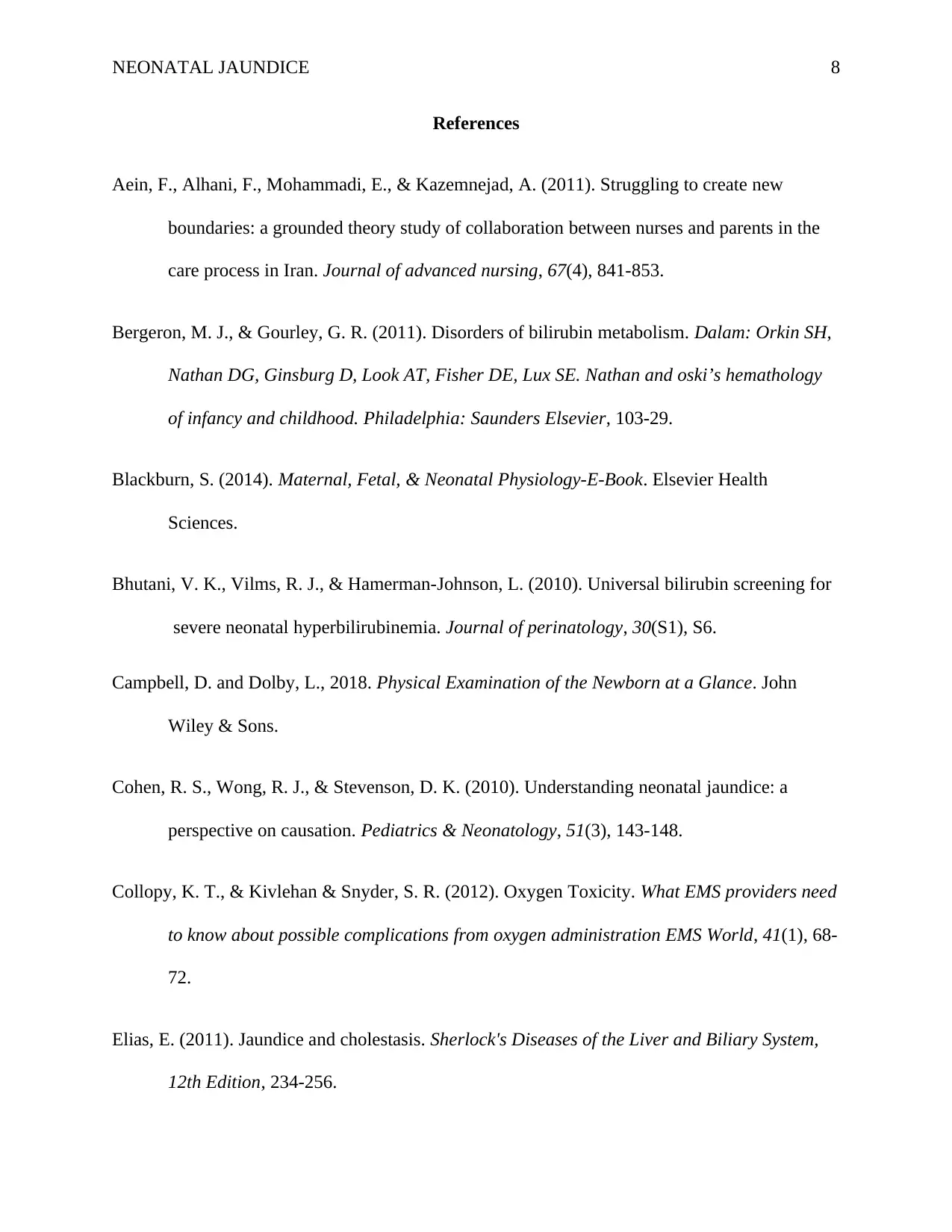
NEONATAL JAUNDICE 8
References
Aein, F., Alhani, F., Mohammadi, E., & Kazemnejad, A. (2011). Struggling to create new
boundaries: a grounded theory study of collaboration between nurses and parents in the
care process in Iran. Journal of advanced nursing, 67(4), 841-853.
Bergeron, M. J., & Gourley, G. R. (2011). Disorders of bilirubin metabolism. Dalam: Orkin SH,
Nathan DG, Ginsburg D, Look AT, Fisher DE, Lux SE. Nathan and oski’s hemathology
of infancy and childhood. Philadelphia: Saunders Elsevier, 103-29.
Blackburn, S. (2014). Maternal, Fetal, & Neonatal Physiology-E-Book. Elsevier Health
Sciences.
Bhutani, V. K., Vilms, R. J., & Hamerman-Johnson, L. (2010). Universal bilirubin screening for
severe neonatal hyperbilirubinemia. Journal of perinatology, 30(S1), S6.
Campbell, D. and Dolby, L., 2018. Physical Examination of the Newborn at a Glance. John
Wiley & Sons.
Cohen, R. S., Wong, R. J., & Stevenson, D. K. (2010). Understanding neonatal jaundice: a
perspective on causation. Pediatrics & Neonatology, 51(3), 143-148.
Collopy, K. T., & Kivlehan & Snyder, S. R. (2012). Oxygen Toxicity. What EMS providers need
to know about possible complications from oxygen administration EMS World, 41(1), 68-
72.
Elias, E. (2011). Jaundice and cholestasis. Sherlock's Diseases of the Liver and Biliary System,
12th Edition, 234-256.
References
Aein, F., Alhani, F., Mohammadi, E., & Kazemnejad, A. (2011). Struggling to create new
boundaries: a grounded theory study of collaboration between nurses and parents in the
care process in Iran. Journal of advanced nursing, 67(4), 841-853.
Bergeron, M. J., & Gourley, G. R. (2011). Disorders of bilirubin metabolism. Dalam: Orkin SH,
Nathan DG, Ginsburg D, Look AT, Fisher DE, Lux SE. Nathan and oski’s hemathology
of infancy and childhood. Philadelphia: Saunders Elsevier, 103-29.
Blackburn, S. (2014). Maternal, Fetal, & Neonatal Physiology-E-Book. Elsevier Health
Sciences.
Bhutani, V. K., Vilms, R. J., & Hamerman-Johnson, L. (2010). Universal bilirubin screening for
severe neonatal hyperbilirubinemia. Journal of perinatology, 30(S1), S6.
Campbell, D. and Dolby, L., 2018. Physical Examination of the Newborn at a Glance. John
Wiley & Sons.
Cohen, R. S., Wong, R. J., & Stevenson, D. K. (2010). Understanding neonatal jaundice: a
perspective on causation. Pediatrics & Neonatology, 51(3), 143-148.
Collopy, K. T., & Kivlehan & Snyder, S. R. (2012). Oxygen Toxicity. What EMS providers need
to know about possible complications from oxygen administration EMS World, 41(1), 68-
72.
Elias, E. (2011). Jaundice and cholestasis. Sherlock's Diseases of the Liver and Biliary System,
12th Edition, 234-256.
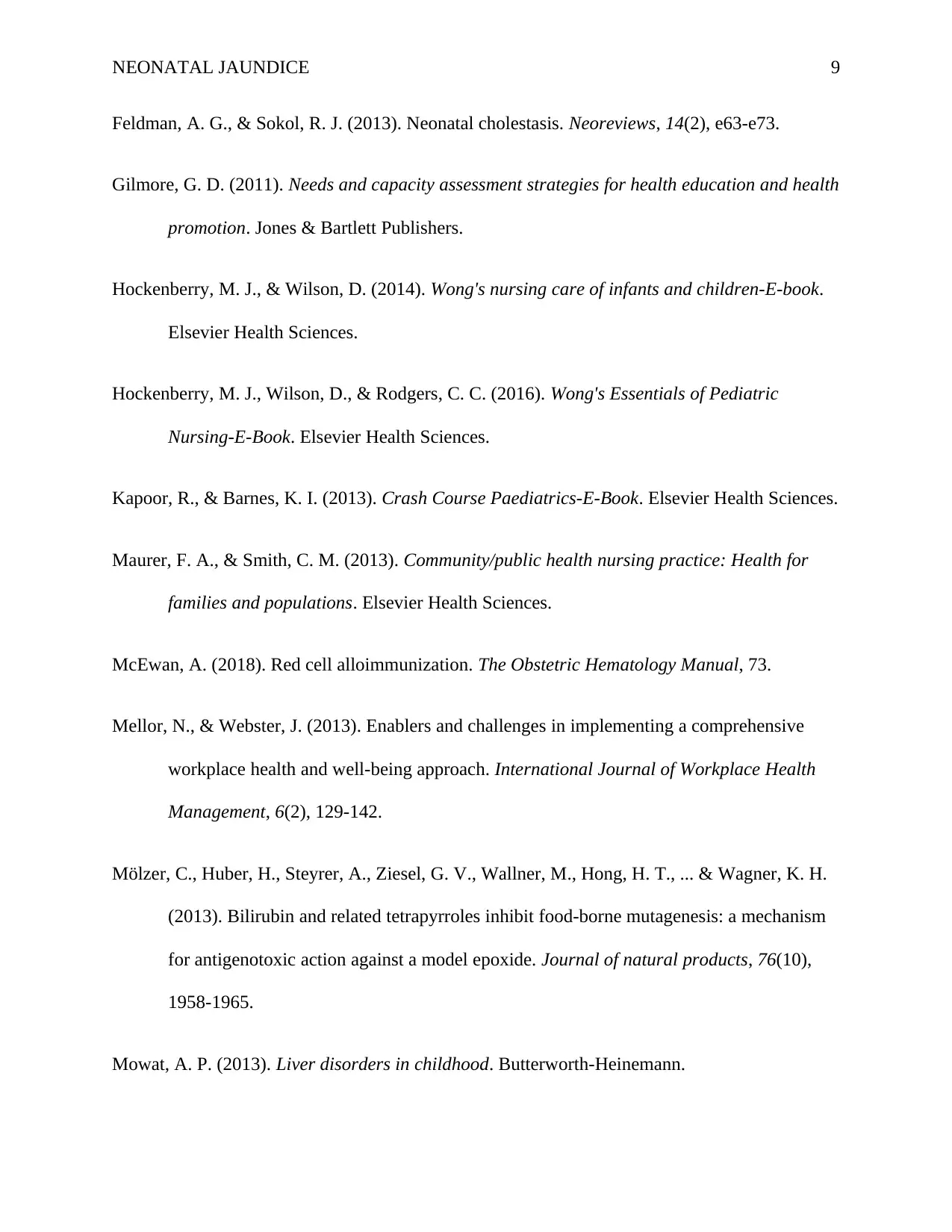
NEONATAL JAUNDICE 9
Feldman, A. G., & Sokol, R. J. (2013). Neonatal cholestasis. Neoreviews, 14(2), e63-e73.
Gilmore, G. D. (2011). Needs and capacity assessment strategies for health education and health
promotion. Jones & Bartlett Publishers.
Hockenberry, M. J., & Wilson, D. (2014). Wong's nursing care of infants and children-E-book.
Elsevier Health Sciences.
Hockenberry, M. J., Wilson, D., & Rodgers, C. C. (2016). Wong's Essentials of Pediatric
Nursing-E-Book. Elsevier Health Sciences.
Kapoor, R., & Barnes, K. I. (2013). Crash Course Paediatrics-E-Book. Elsevier Health Sciences.
Maurer, F. A., & Smith, C. M. (2013). Community/public health nursing practice: Health for
families and populations. Elsevier Health Sciences.
McEwan, A. (2018). Red cell alloimmunization. The Obstetric Hematology Manual, 73.
Mellor, N., & Webster, J. (2013). Enablers and challenges in implementing a comprehensive
workplace health and well-being approach. International Journal of Workplace Health
Management, 6(2), 129-142.
Mölzer, C., Huber, H., Steyrer, A., Ziesel, G. V., Wallner, M., Hong, H. T., ... & Wagner, K. H.
(2013). Bilirubin and related tetrapyrroles inhibit food-borne mutagenesis: a mechanism
for antigenotoxic action against a model epoxide. Journal of natural products, 76(10),
1958-1965.
Mowat, A. P. (2013). Liver disorders in childhood. Butterworth-Heinemann.
Feldman, A. G., & Sokol, R. J. (2013). Neonatal cholestasis. Neoreviews, 14(2), e63-e73.
Gilmore, G. D. (2011). Needs and capacity assessment strategies for health education and health
promotion. Jones & Bartlett Publishers.
Hockenberry, M. J., & Wilson, D. (2014). Wong's nursing care of infants and children-E-book.
Elsevier Health Sciences.
Hockenberry, M. J., Wilson, D., & Rodgers, C. C. (2016). Wong's Essentials of Pediatric
Nursing-E-Book. Elsevier Health Sciences.
Kapoor, R., & Barnes, K. I. (2013). Crash Course Paediatrics-E-Book. Elsevier Health Sciences.
Maurer, F. A., & Smith, C. M. (2013). Community/public health nursing practice: Health for
families and populations. Elsevier Health Sciences.
McEwan, A. (2018). Red cell alloimmunization. The Obstetric Hematology Manual, 73.
Mellor, N., & Webster, J. (2013). Enablers and challenges in implementing a comprehensive
workplace health and well-being approach. International Journal of Workplace Health
Management, 6(2), 129-142.
Mölzer, C., Huber, H., Steyrer, A., Ziesel, G. V., Wallner, M., Hong, H. T., ... & Wagner, K. H.
(2013). Bilirubin and related tetrapyrroles inhibit food-borne mutagenesis: a mechanism
for antigenotoxic action against a model epoxide. Journal of natural products, 76(10),
1958-1965.
Mowat, A. P. (2013). Liver disorders in childhood. Butterworth-Heinemann.
⊘ This is a preview!⊘
Do you want full access?
Subscribe today to unlock all pages.

Trusted by 1+ million students worldwide
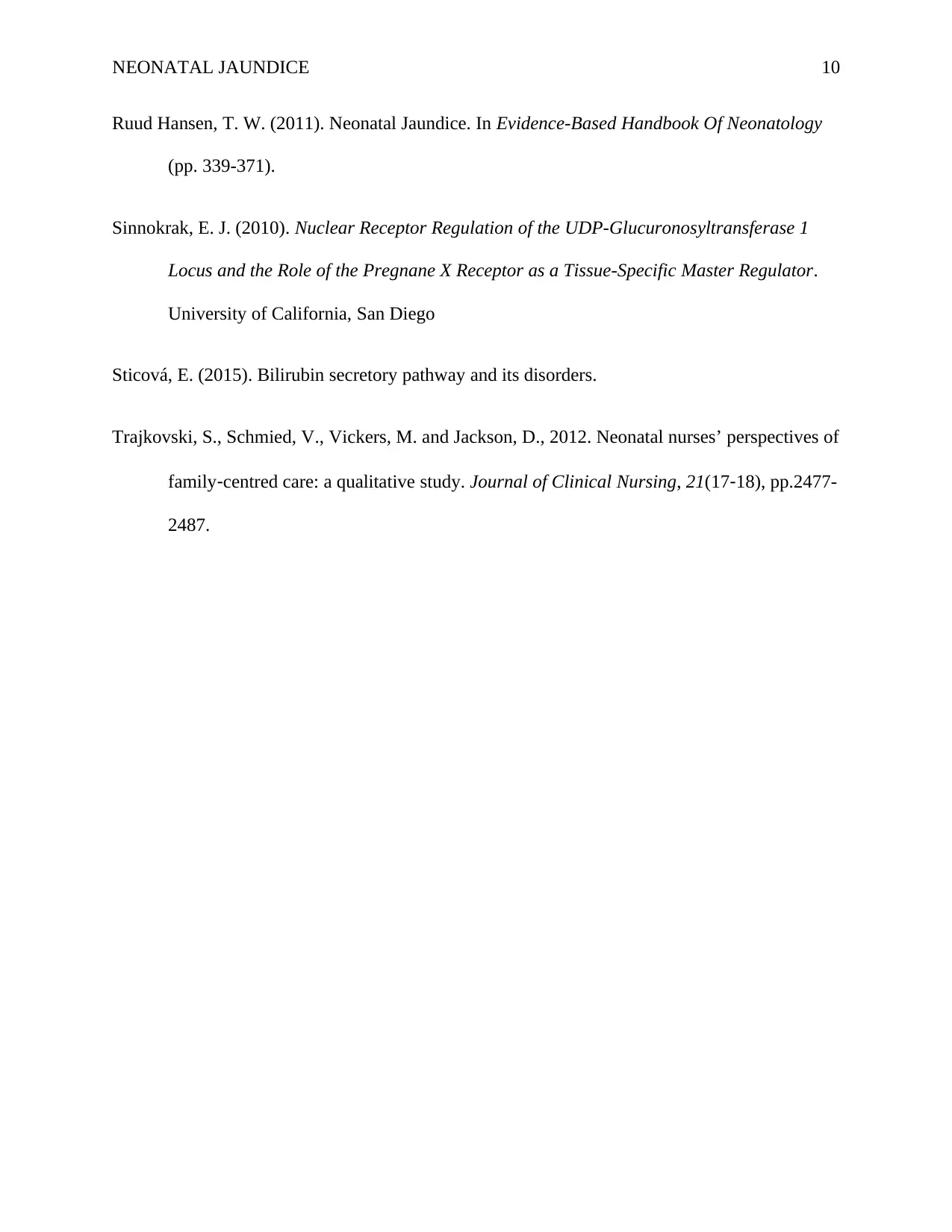
NEONATAL JAUNDICE 10
Ruud Hansen, T. W. (2011). Neonatal Jaundice. In Evidence-Based Handbook Of Neonatology
(pp. 339-371).
Sinnokrak, E. J. (2010). Nuclear Receptor Regulation of the UDP-Glucuronosyltransferase 1
Locus and the Role of the Pregnane X Receptor as a Tissue-Specific Master Regulator.
University of California, San Diego
Sticová, E. (2015). Bilirubin secretory pathway and its disorders.
Trajkovski, S., Schmied, V., Vickers, M. and Jackson, D., 2012. Neonatal nurses’ perspectives of
family‐centred care: a qualitative study. Journal of Clinical Nursing, 21(17‐18), pp.2477-
2487.
Ruud Hansen, T. W. (2011). Neonatal Jaundice. In Evidence-Based Handbook Of Neonatology
(pp. 339-371).
Sinnokrak, E. J. (2010). Nuclear Receptor Regulation of the UDP-Glucuronosyltransferase 1
Locus and the Role of the Pregnane X Receptor as a Tissue-Specific Master Regulator.
University of California, San Diego
Sticová, E. (2015). Bilirubin secretory pathway and its disorders.
Trajkovski, S., Schmied, V., Vickers, M. and Jackson, D., 2012. Neonatal nurses’ perspectives of
family‐centred care: a qualitative study. Journal of Clinical Nursing, 21(17‐18), pp.2477-
2487.
1 out of 10
Your All-in-One AI-Powered Toolkit for Academic Success.
+13062052269
info@desklib.com
Available 24*7 on WhatsApp / Email
![[object Object]](/_next/static/media/star-bottom.7253800d.svg)
Unlock your academic potential
Copyright © 2020–2025 A2Z Services. All Rights Reserved. Developed and managed by ZUCOL.
